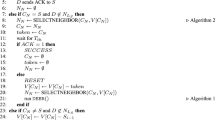Abstract
In this paper, we propose a lexical routing metric to enable path-wise link quality-aware routing in Wireless Sensor Networks (WSNs). The realization of this routing metric is achieved by applying the indexing techniques of formal language processing in multi-metric route classification and cost evaluation for WSNs. In particular, the metric is motivated from the fact that IEEE 802.15.4 networks are formed on links with highly variable quality, and selection of poor quality links degrades the data delivery considerably. Although IEEE 802.15.4 supports link-level awareness through LQI, (a) it remains unbeknownst at the path level, and therefore, (b) its processing is link-local in scope. We propose LABILE, a composite routing metric, that is implemented through modifying RREQ and RREP structures of AODV to capture and convey two-state link information to destination which in turn is processed through an easy to compute routing lexicon and a corresponding lexical algorithm for path selection in case of availability of multiple paths. Multiple paths are represented in a path space through a proposed cost model that encompasses hop-count, weak links and a quantity weakness factor of each link, depending upon a thresholding mechanism which in turn declares a link to be either healthy (aka usable) or weak (aka unusable). Using the weakness factor, the success probability of data delivery over weak link turns out to be a fraction of success probability at healthy link. The mathematical model along with the experiments done for LABILE show that proposed composite metric and its parsing scheme together achieve link robustness consistently by evading the link failures, as the number of weak links is fairly reduced in lexical path as compared to the hop-count-based metric. Increased data delivery is obtained through preventing retransmissions as on failure-prone links.
Similar content being viewed by others
References
Perkins C, Belding-Royer E, Das S, (2003) Ad hoc On-Demand Distance Vector (AODV) routing. RFC 3561
ZigBee Specifications, ZigBee Document (2005) [ZigBee Alliance], 053474r06. ver. 1.0
Iannone L, Khalili R, Salamatian K, Fdida S (2004) Cross-layer routing in wireless mesh networks. In: Proc 1st international symposium on wireless communication systems (ISWCS)
Zhao S, Wu Z, Acharya A, Raychaudhuri D (2005) PARMA: a PHY/MAC aware routing metric for ad-hoc wireless networks with multi-rate radios. In: Proc IEEE intl symp world wireless, mobil multimed network (WoWMoM)
Pursley MB, Russell HB, Wysocarski JS (2000) Tradeoffs in the design of routing metrics for frequency-hop wireless networks. In: Proc IEEE mil comm conf (MILCOM), vol 1, pp 65–69
Couto DSJD, Aguayo D, Bicket J, Morris R (2003) A high-throughput path metric for multi-hop wireless routing. In: Proc MOBICOM
Kortenkamp U Experimental Mathematics and Proofs in the Classroom (2004) Intl Rev Math Educat 36(2):61–66
Gouda MG, Schneider M (2003) Maximizable routing metrics. IEEE/ACM Trans Netw 11(4):663–675
Tsai HM, Wisitpongphan N, Ozan KT (2006) Link-quality aware ad hoc on-demand distance vector routing protocol. In: Proc ISWPC
Srinivasan K, Dutta P, Tavakoli A, Levis P (2008) An empirical study of low power wireless. SING Tech Report
Suhua T, Bing Z et al (2005) A link heterogeneity-aware on-demand routing (LHAOR) protocol utilizing local update and RSSI information. IEICE Trans Commun E88-B(9):3588–3597
Xiao L, Wang J, Nahrstedt K (2002) Ticket based routing algorithm. In: Proc ICC
Haenggi M (2004) Twelve reasons not to route over many short hops. In: Proc IEE VTC
Zhu J, Zhao H, Xu J (2009) An energy balanced reliable routing metric in WSNs wireless sensor. Networks 1:1–60
Javed MM, Butt MR, Akbar AH, Omar A (2009) A lexicon based cost evaluation for multi-metric routing protocols in wireless sensor networks. In: Proc IEEE INMIC
Cao L, Sharif K, Teresa YW, Dahlberg (2009) Multiple-metric hybrid routing protocol for heterogeneous wireless access networks. In: Proc 6th IEEE CCNC
Kim KH, Park SD, Montenegro G, Yoo S (2006) 6LowPAN ad hoc on-demand distance vector routing (LOAD). draft-daniel-6lowpan-load-adhoc-routing-01.txt
Montenegro G, Kushalnagar N (2006) Transmission of IPv6 Packets over IEEE 802.15.4 Networks. draft-ietf-6lowpan-format-00.txt
RFC 1771-A (2011) Border Gateway Protocol 4 (BGP-4)
Cohen DI (1991) Introduction to computing theory. Wiley, New York
Gomez C, Boix A, Paradells J (2010) Impact of LQI-based routing metrics on the performance of a one-to-one routing protocol for IEEE 802.15.4 multihop networks. Eur J WCN (in press)
Gupta A, Sharma M, Marot M, Becker M (2010) HybridLQI: hybrid multihopLQI for improving asymmetric links in wireless sensor networks. In: Proc AICT
Liange JJ, Yuan ZW, Lei JJ, Kwon GI (2010) Reliable routing algorithm for wireless sensor network. In: Proc ICACT
Diallo C, Marot M, Becker M (2010) Link quality and local load balancing routing mechanisms in wireless sensor networks. In: Proc AICT
Yan C, Hu J, Shen L, Song T (2009) RPLRE: a routing protocol based on LQI and residual energy for wireless sensor network. In: Proc ICISE
Kwon J, Ahn G, Kim S, Kang S, Kim H (2009) A study on energy-efficient tree routing protocol based on link metrics for remote air environmental monitoring system. In: Proc ICROS-SICE
Author information
Authors and Affiliations
Corresponding author
Additional information
Labile affect refers to changing moods in humans which affect their relationships in society.
Rights and permissions
About this article
Cite this article
Butt, M.R., Akbar, A.H., Kim, KH. et al. LABILE: link quAlity-based lexIcaL routing mEtric for reactive routing protocols in IEEE 802.15.4 networks. J Supercomput 62, 84–104 (2012). https://doi.org/10.1007/s11227-011-0622-4
Published:
Issue Date:
DOI: https://doi.org/10.1007/s11227-011-0622-4




